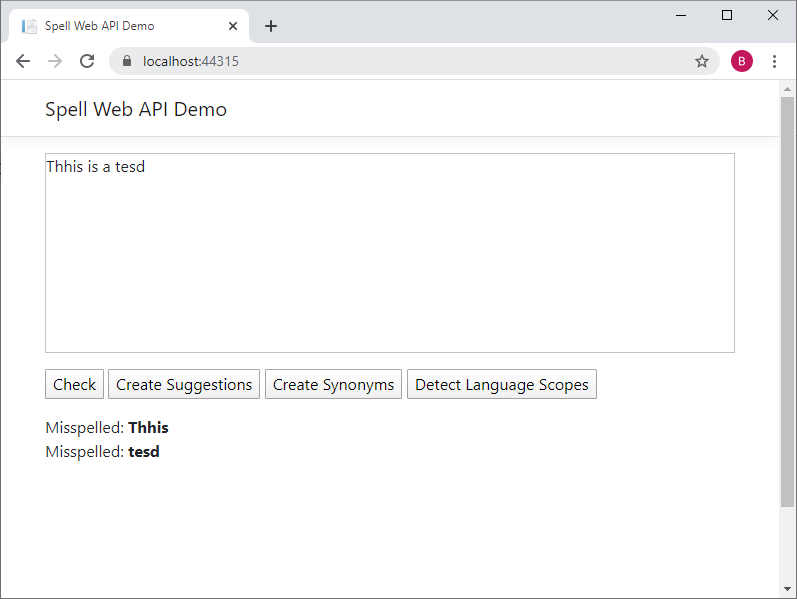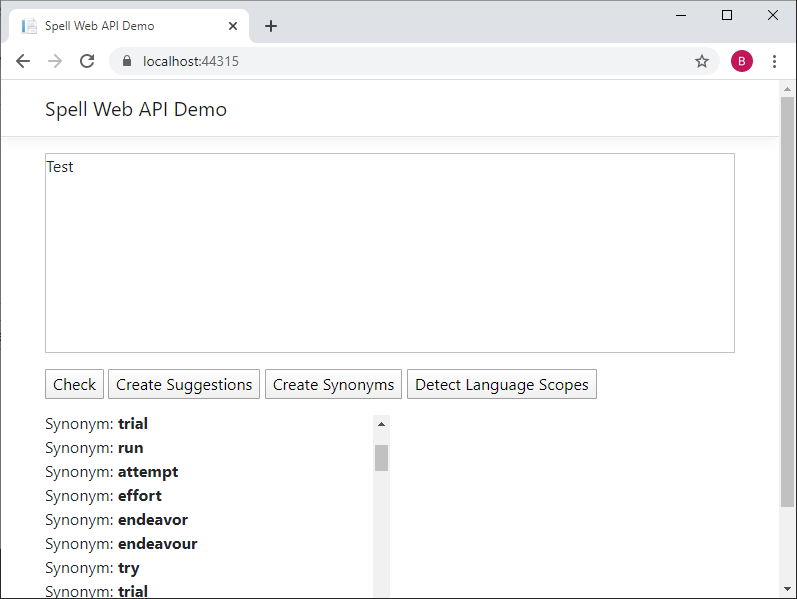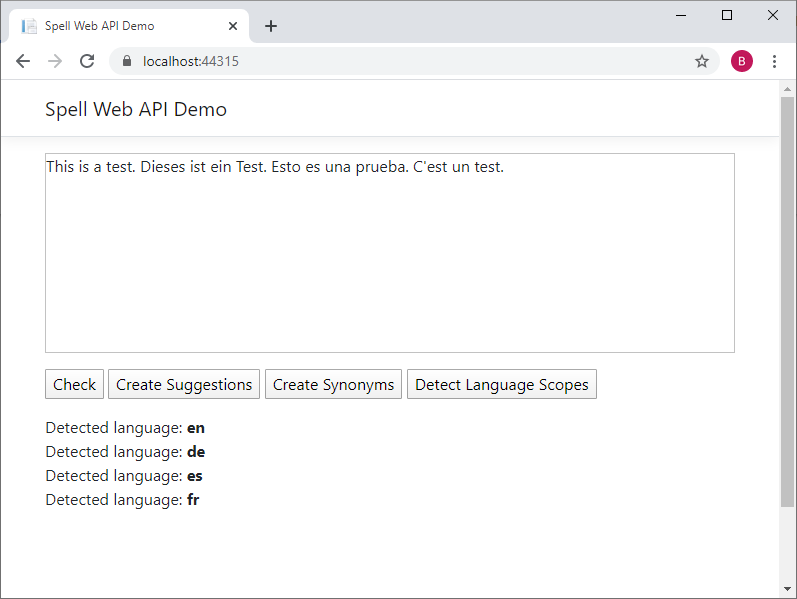Building a Spell Checking Web API in ASP.NET Core
TX Spell .NET provides a fully-featured spell checking interface and integration when used with TX Text Control editors. But it can be used without a UI as a spell checking engine as well. This sample shows how to create a spell checking Web API in ASP.NET Core.

TX Spell .NET is a very powerful spell checking engine with a tight integration into the document editors from Text Control including ASP.NET, Angular and Windows Forms. It provides fully-featured UI elements including dialog boxes and context menus when connected to a Text Control instance.
Non-Visual Spell Engine
But the product also includes the non-visual component TXSpell that can be used for background processing. This sample shows how to use this class to create a spell checking Web API using ASP.NET Core.
Implementing the Web API Controller
The sample implements the Web API controller SpellController:
[Route("api/[controller]")]
[ApiController]
public class SpellController : ControllerBase
{
}This controller implements 4 endpoints:
- Check
- CreateSuggestions
- CreateSynonyms
- DetectLanguageScopes
The following code shows the implementation of the Check method that accepts the Text to be checked and an optional language identifier:
[HttpGet]
[Route("Check")]
public List<IncorrectWordModel> Check(string text, string language = "en_US")
{
if (text == null)
return null;
// create a new spell checking engine
TXTextControl.Proofing.TXSpell spell = new TXTextControl.Proofing.TXSpell();
spell.Create();
TXTextControl.Proofing.OpenOfficeDictionary dict =
new OpenOfficeDictionary(@"Dictionaries\en_US.dic");
spell.Dictionaries.Add(dict);
spell.Check(text, new System.Globalization.CultureInfo(language));
List<IncorrectWordModel> lIncorrectWords = new List<IncorrectWordModel>();
var incorrectWords = spell.IncorrectWords;
if (incorrectWords == null)
return null;
foreach (IncorrectWord word in incorrectWords)
{
lIncorrectWords.Add(new IncorrectWordModel()
{
Text = word.Text,
Index = word.Index,
IsDuplicate = word.IsDuplicate,
Length = word.Length,
Start = word.Start
});
}
return lIncorrectWords;
}In the method Check, a new instance of the spell checker is created and a dictionary is loaded and added to the available dictionaries using the Dictionaries.
The given Text is checked using the Check method and the results are returned as a list of IncorrectWords.
Calling from JavaScript
On the JavaScript side, the endpoint is called using a jQuery ajax call:
async function check(text, language = "en_US") {
var serviceURL = "api/spell/check?text=" + text + "&language=" + language;
return await callEndpoint(serviceURL);
}async function callEndpoint(serviceURL) {
return new Promise(resolve => {
$.ajax({
type: "GET",
url: serviceURL,
contentType: 'application/json',
success: successFunc,
error: errorFunc
});
function successFunc(data, status) {
resolve(data);
}
function errorFunc(data) {
throw "Request failed. Please try again later.";
}
});
}The spell checking functions are encapsulated in a private scope and exposed as properties in the TXSpell JavaScript object. This way, the check method can be called like this in the sample:
async function checkText() {
// call the check method
var results = await TXSpell.check(document.getElementById('textbox').textContent);
// check console for details
console.log(results);
var consoleText = "";
// loop through the results and return the text
results.forEach(function (element) {
consoleText += "<p>Misspelled: <strong>" + element.text + "</strong></p>";
});
document.getElementById('results').innerHTML = consoleText;
}On a button click, the function checkText is called:
<input value="Check" type="button" onclick="checkText()" />Demo Screenshots
The following screenshot shows the sample after the Check button has been clicked:

Create Suggestions:

Create Synonyms:

Detect Languages:

Download the sample project and test this on your own.
Also See
This post references the following in the documentation:
- TXText
Control. Proofing. Incorrect Word Class - TXText
Control. Proofing. Open Office Dictionary Class - TXText
Control. Proofing. TXSpell. Check Method - TXText
Control. Proofing. TXSpell Class - TXText
Control. Proofing. TXSpell. Create Suggestions Method - TXText
Control. Proofing. TXSpell. Create Synonyms Method
![]()
Download and Fork This Sample on GitHub
We proudly host our sample code on github.com/TextControl.
Please fork and contribute.
Requirements for this sample
- TX Spell .NET 7
- Visual Studio 2019
ASP.NET
Integrate document processing into your applications to create documents such as PDFs and MS Word documents, including client-side document editing, viewing, and electronic signatures.
- Angular
- Blazor
- React
- JavaScript
- ASP.NET MVC, ASP.NET Core, and WebForms
Related Posts
TX Text Control 34.0 SP1 is Now Available: What's New in the Latest Version
TX Text Control 34.0 Service Pack 1 is now available, offering important updates and bug fixes for all platforms. If you use TX Text Control in your document processing applications, this service…
Introducing TX Text Control 34.0: Your Next Leap in Document Processing.
We are happy to announce the release of TX Text Control 34.0. This version is packed with new features and enhancements that will elevate your document processing experience. This version…
Sneak Peek: TX Text Control 34.0 Coming November 2025
We are excited to announce the upcoming release of TX Text Control 34.0, scheduled for November 2025. This update brings a host of new features and improvements to enhance your document processing…
TX Text Control 33.0 SP3 is Now Available: What's New in the Latest Version
TX Text Control 33.0 Service Pack 3 is now available, offering important updates and bug fixes for all platforms. If you use TX Text Control in your document processing applications, this service…
TX Text Control 33.0 SP2 is Now Available: What's New in the Latest Version
TX Text Control 33.0 Service Pack 2 is now available, offering important updates and bug fixes for all platforms. If you use TX Text Control in your document processing applications, this service…






